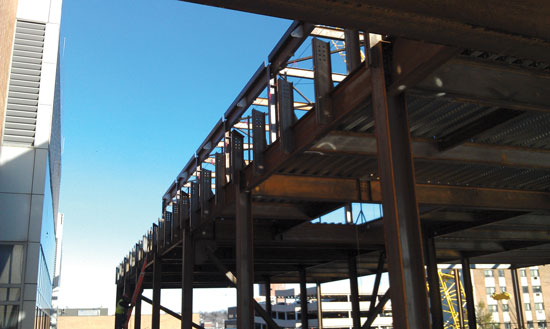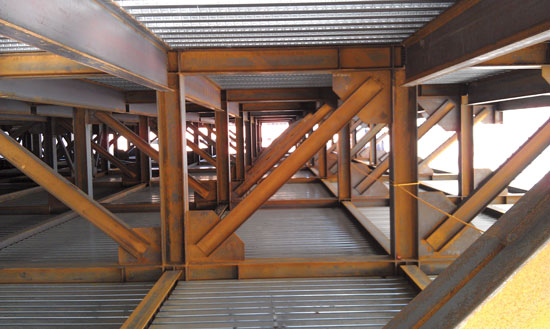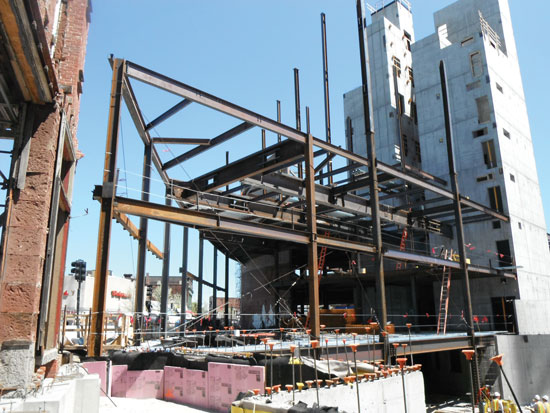Weight Watching: Adaptive Reuse with Structural Steel


Photo courtesy of MKA
At the State University of New York Institute of Human Performance Upstate Medical University, structural steel was selected for this laboratory expansion project. Pictured above, upper floor and mechanical penthouse levels of the steel frame with horizontal bracing members at the roof and attachments will support a tied-back infill skylight. In the photo to the right, the full-story transfer girders serving as an interstitial-level MEP services distribution zone can be seen.
Comparing Concrete
Consider concrete, for example. In addition to the fact that concrete’s additional weight will increase foundation costs, in many cases this will also require the implementation of piles, caissons, mat-slab, or other deep foundations, which can easily create an unfavorable embodied-energy equation, explains Michael Liu, AIA, principal and vice president of The Architectural Team in Boston.
Or more simply stated, “An average concrete floor weight is 100 psf, as compared to steel, with a lightweight deck of 40 psf,” says Janis B. Vacca, P.E., vice president and principal of The Harman Group in Philadelphia. “That means you can get two floors of steel for every one floor of concrete.”
Another big difference with reinforced concrete, or masonry for that matter, is that it’s usually more difficult to apply it to a dissimilar existing building material, such as structural steel, requiring welding or bolting via studs or dowels to attach and interface the two materials, according to Jimmy Su, P.E., LEED AP, an associate structural engineer for Arup Boston. “There is usually more benefit to simply attaching new steel to existing steel with the same effort, and offering the advantage of smaller sizes for similar strength and more flexibility in connection configurations. In the case of existing wood, it is nearly impossible,” he says.
Raising another point about wood, Su adds that it is generally weaker when force is applied perpendicular to its grain, and this can create complications when one is attempting to reinforce or connect to wood. In addition, connection sizes into wood members can often be quite large because of the area required to disperse the force down to a level that won’t damage the material. The unfortunate upshot is many rows of nails or bolts spread out over a larger area.
Steel-to-steel connections also have very high capacities for relatively small connection areas. For example, bolt holes on the order of a ¾-inch to 1½-inch diameter or single-digit inches of weld, according to Su. In fact, one can derive thousands of pounds of capacity out of bolted or welded connections that take up just a few inches.
In terms of opening up a space, which could involve the removal of a column, adding steel framing to reinforce existing structural framing is considered a fairly straightforward endeavor, void of messy, disruptive construction, adds Reynolds.
Add the efficiencies inherent in prefabrication, and this enables structural steel elements to be installed while portions of an existing building remain occupied.
Yet another advantage is the fact that structural steel framing works well in resisting lateral loads. “The lower weight can keep lateral seismic forces lower, which can minimize or avoid the need to reinforce existing lateral load resisting systems,” says Gottlieb.
Bringing in another point, Reynolds explains that for exterior support facades, steel framing is a great solution, particularly in cases where the exterior walls are being upgraded to include tensioned glazing systems or blast loads. This is because it leverages one of steel’s greatest strengths—the ability to resist tension loads with compact sections.
Specifically regarding adaptive reuse, William D. Bast, P.E., S.E., principal at Thornton Tomasetti’s Chicago office, highlights the following:
The prefabricated nature of steel can be an advantage in avoiding formwork and/or the need to vacate space within the building during construction. Steel members can be shallower or narrower than corresponding concrete members and therefore provide an advantage in ceiling or headroom program requirements. Steel can be used for temporary means and methods, such as shoring or bracing, and then become part of the permanent structural system. Structural steel is easily beneficial in filling-in floor openings due to its lightweight nature and ability to avoid the need for shoring.

Photo courtesy of Arup
Incorporating Boston’s historic Curtis and Waterman buildings, and uniting their facades with five additional stories of structural steel, Arup worked with Sasaki Associates to design this new 215,000-square-foot headquarters for the Boston Public School system.









